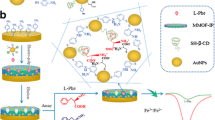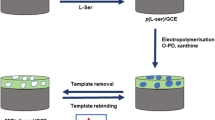Abstract
This work reports on a modularized electrochemical method for the determination of the hormones cortisol, progesterone, testosterone and 17β-estradiol in urine. These hormones were employed as templates when generating molecular imprints from aniline and metanilic acid by electropolymerization on the surface of screen-printed electrodes. The electrically conductive imprint was characterized by SEM, AFM and cyclic voltammetry. A four-channel system was then established to enable simultaneous determination of the hormones by cyclic voltammetry. The detection limits for cortisol, progesterone, testosterone and 17β-estradiol are as low as 2, 2.5, 10 and 9 ag·mL−1 (for S/N = 3).

A four-channel system was established to enable simultaneous determination of 4 steroid hormones by cyclic voltammetry and by using moleculalry imprinted polymers.






Similar content being viewed by others
References
Norman AW, Litwack G (1997) Hormones. Academic Press
Dickerson SS, Kemeny ME (2004) Acute stressors and cortisol responses: a theoretical integration and synthesis of laboratory research. Psychol Bull 130(3):355–391
Hucklebridge F, Clow A, Abeyguneratne T, Huezo-Diaz P, Evans P (1999) The awakening cortisol response and blood glucose levels. Life Sci 64(11):931–937
Barbieri RL (2014) The endocrinology of the menstrual cycle. In: Rosenwaks Z, Wassarman PM (eds) Human fertility: methods and protocols. Springer, New York, New York, NY, pp 145–169. https://doi.org/10.1007/978-1-4939-0659-8_7
Marco F (2015) Clinical roles and applications of progesterone in reproductive medicine: an overview. Acta Obstet Gynecol Scand 94 (S161:3–7. https://doi.org/10.1111/aogs.12791
Blakemore S-J (2008) The social brain in adolescence. Nat Rev Neurosci 9(4):267–277
Erickson GF, Magoffin DA, Dyer CA, Hofeditz C (1985) The ovarian androgen producing cells: a review of structure/function relationships. Endocr Rev 6(3):371–399
Dalal PK, Agarwal M (2015) Postmenopausal syndrome. Indian J Psychiatry 57(Suppl 2):S222–S232. https://doi.org/10.4103/0019-5545.161483
Huang C-Y, O'Hare D, Chao IJ, Wei H-W, Liang Y-F, Liu B-D, Lee M-H, Lin H-Y (2015) Integrated potentiostat for electrochemical sensing of urinary 3-hydroxyanthranilic acid with molecularly imprinted poly(ethylene-co-vinyl alcohol). Biosens Bioelectron 67:208–213. https://doi.org/10.1016/j.bios.2014.08.018
Huang C-Y, Tsai T-C, Thomas JL, Lee M-H, Liu B-D, Lin H-Y (2009) Urinalysis with molecularly imprinted poly(ethylene-co-vinyl alcohol) potentiostat sensors. Biosens Bioelectron 24(8):2611–2617. https://doi.org/10.1016/j.bios.2009.01.016
Zhao G, Si Y, Wang H, Liu G (2016) A portable electrochemical detection system based on graphene/ionic liquid modified screen-printed electrode for the detection of cadmium in soil by square wave anodic stripping voltammetry. Int J Electrochem Sci 11:54–64
Yin L-T, Wang H-Y, Lin Y-C, Huang W-C (2012) A novel instrumentation circuit for electrochemical measurements. Sensors (Basel, Switzerland) 12(7):9687–9696. https://doi.org/10.3390/s120709687
Janata J, Josowicz M (2003) Conducting polymers in electronic chemical sensors. Nat Mater 2(1):19–24
Sharma PS, Pietrzyk-Le A, D’Souza F, Kutner W (2012) Electrochemically synthesized polymers in molecular imprinting for chemical sensing. Anal Bioanal Chem 402(10):3177–3204. https://doi.org/10.1007/s00216-011-5696-6
Malitesta C, Mazzotta E, Picca RA, Poma A, Chianella I, Piletsky SA (2012) MIP sensors – the electrochemical approach. Anal Bioanal Chem 402(5):1827–1846. https://doi.org/10.1007/s00216-011-5405-5
Sreenivasan K (2007) Identification of salicylic acid using surface modified polyurethane film using an imprinted layer of polyaniline. Anal Chim Acta 583(2):284–288. https://doi.org/10.1016/j.aca.2006.10.019
Najafi M, Mollazadeh M (2011) Selective recognition of chloroacetic acids by imprinted polyaniline film. J Appl Polym Sci 121(1):292–298
Roy AK, Dhand C, Malhotra BD (2011) Molecularly imprinted polyaniline film for ascorbic acid detection. J Mol Recognit 24(4):700–706
Roy AC, Nisha V, Dhand C, Ali MA, Malhotra B (2013) Molecularly imprinted polyaniline-polyvinyl sulphonic acid composite based sensor for Para-nitrophenol detection. Anal Chim Acta 777:63–71
Saadati F, Ghahramani F, Shayani-jam H, Piri F, Yaftian MR (2018) Synthesis and characterization of nanostructure molecularly imprinted polyaniline/graphene oxide composite as highly selective electrochemical sensor for detection of p-nitrophenol. J Taiwan Inst Chem Eng 86:213–221. https://doi.org/10.1016/j.jtice.2018.02.019
Lee M-H, O'Hare D, Guo H-Z, Yang C-H, Lin H-Y (2016) Electrochemical sensing of urinary progesterone with molecularly imprinted poly(aniline-co-metanilic acid)s. J Mater Chem B 4(21):3782–3787. https://doi.org/10.1039/C6TB00760K
Luo SC, Thomas JL, Guo HZ, Liao WT, Lee MH, Lin HY (2017) Electrosynthesis of nanostructured, imprinted poly(hydroxymethyl 3,4-ethylenedioxythiophene) for the ultrasensitive electrochemical detection of urinary progesterone. ChemistrySelect 2(26):7935–7939. https://doi.org/10.1002/slct.201701469
Hrichi H, Monser L, Adhoum N (2017) A novel electrochemical sensor based on electropolymerized molecularly imprinted poly(aniline-co-anthranilic acid) for sensitive detection of amlodipine. J Electroanal Chem 805:133–145. https://doi.org/10.1016/j.jelechem.2017.10.019
Yang C-H, Chih Y-K, Cheng H-E, Chen C-H (2005) Nanofibers of self-doped polyaniline. Polymer 46(24):10688–10698. https://doi.org/10.1016/j.polymer.2005.09.044
Yang CH, Wen TC (1994) Polyaniline derivative with external and internal doping via electrochemical copolymerization of aniline and 2,5-Diaminobenzenesulfonic acid on IrO2 - coated titanium electrode. J Electrochem Soc 141(10):2624–2632. https://doi.org/10.1149/1.2059144
Macdiarmid AG, Chiang JC, Richter AF, Epstein AJ (1987) Polyaniline: a new concept in conducting polymers. Synth Met 18(1):285–290. https://doi.org/10.1016/0379-6779(87)90893-9
Stilwell DE, Park SM (1988) Electrochemistry of conductive polymers: III . Some physical and electrochemical properties observed from electrochemically grown polyaniline. J Electrochem Soc 135(10):2491–2496. https://doi.org/10.1149/1.2095364
Duić L, Mandić Z (1992) Counter-ion and pH effect on the electrochemical synthesis of polyaniline. J Electroanal Chem 335(1–2):207–221
Murase N, Taniguchi S-i, Takano E, Kitayama Y, Takeuchi T (2016) A molecularly imprinted nanocavity-based fluorescence polarization assay platform for cortisol sensing. J Mater Chem B 4(10):1770–1777. https://doi.org/10.1039/C5TB02069G
Murase N, Taniguchi SI, Takano E, Kitayama Y, Takeuchi T (2015) Fluorescence reporting of binding interactions of target molecules with Core–Shell-type cortisol-imprinted polymer particles using environmentally responsible fluorescent-labeled cortisol. Macromol Chem Phys 216(13):1396–1404. https://doi.org/10.1002/macp.201500065
Suda N, Sunayama H, Kitayama Y, Kamon Y, Takeuchi T (2017) Oriented, molecularly imprinted cavities with dual binding sites for highly sensitive and selective recognition of cortisol. R Soc Open Sci 4(8):170300. https://doi.org/10.1098/rsos.170300
Usha SP, Shrivastav AM, Gupta BD (2017) A contemporary approach for design and characterization of fiber-optic-cortisol sensor tailoring LMR and ZnO/PPY molecularly imprinted film. Biosens Bioelectron 87:178–186. https://doi.org/10.1016/j.bios.2016.08.040
Acknowledgements
The authors would like to appreciate the Ministry of Science and Technology of the Republic of China, Taiwan for financially supporting this research under contract nos. MOST 106-2221-E-390-013-MY3, 106-2314-B-390-001-MY2 and 107-2923-M-390-001-MY3.
Author information
Authors and Affiliations
Corresponding authors
Ethics declarations
Conflict of interest
The author(s) declare that they have no competing interests.
Additional information
Publisher’s note
Springer Nature remains neutral with regard to jurisdictional claims in published maps and institutional affiliations.
Electronic supplementary material
ESM 1
(DOC 1140 kb)
Rights and permissions
About this article
Cite this article
Lee, MH., Thomas, J.L., Liu, WC. et al. A multichannel system integrating molecularly imprinted conductive polymers for ultrasensitive voltammetric determination of four steroid hormones in urine. Microchim Acta 186, 695 (2019). https://doi.org/10.1007/s00604-019-3797-7
Received:
Accepted:
Published:
DOI: https://doi.org/10.1007/s00604-019-3797-7




